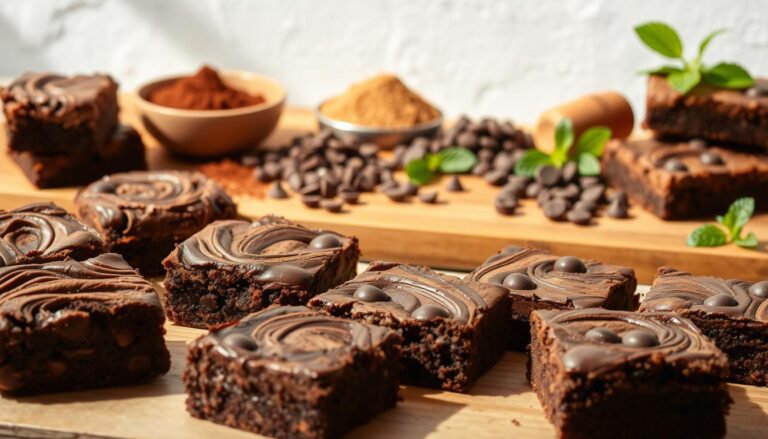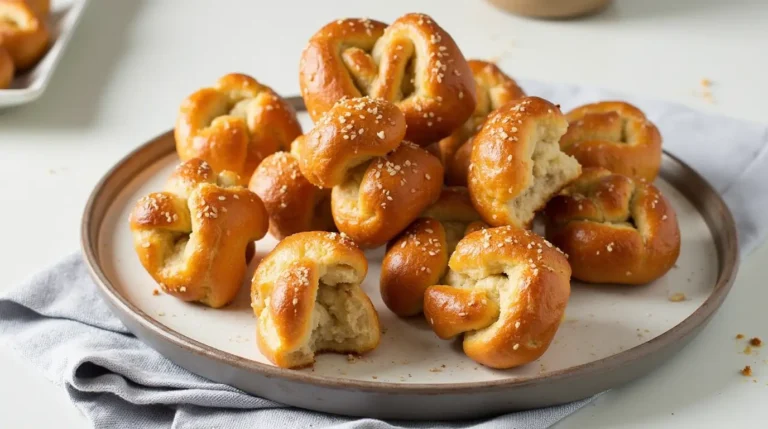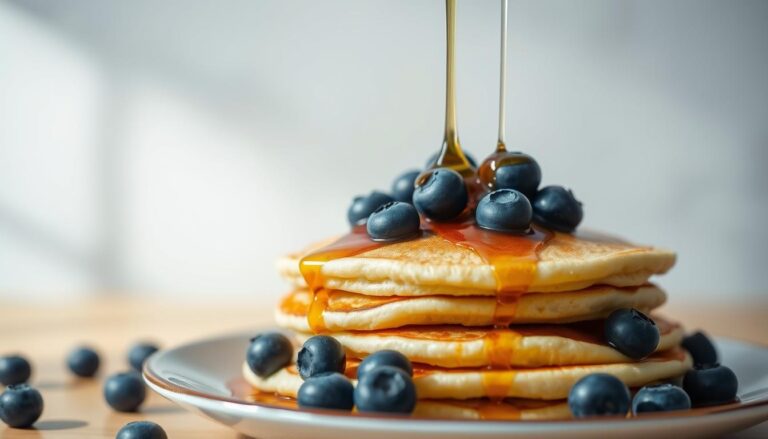Mouth-Watering Breakfast Pastry Recipes
Imagine starting your day with a flaky, buttery croissant or a sweet, sticky danish. Delicious breakfast pastries can make your morning better. And the best part? You can make them at home easily.
Table of Contents
With a bit of creativity and simple ingredients, you can make many mouth-watering breakfast pastries. From classic to new ideas, making breakfast pastries at home is fun and exciting.
Key Takeaways
- Easy-to-make breakfast pastries can elevate your morning routine.
- Simple ingredients can be used to create a variety of delicious pastries.
- Homemade breakfast pastries offer endless possibilities for creativity.
- You can make classic breakfast pastries at home with a few simple ingredients.
- Experimenting with new recipes can help you discover your new favorite breakfast treat.
The Art of Breakfast Pastries
Making homemade breakfast pastries is a fun and rewarding task. It fills your home with amazing smells and gives you a sense of pride. It’s not just about following a recipe. It’s about knowing the ingredients, techniques, and tools that make them special.
Why Homemade Pastries Make Mornings Special
Homemade pastries make mornings feel extra special. They taste and feel different from store-bought ones because they’re made with love. You can also make them your own way, which is great for families or groups.
Essential Equipment for Pastry Making
To start making breakfast pastries, you’ll need some basic tools. You’ll need a mixing bowl, measuring cups, a rolling pin, and a baking sheet. The right tools make the process easier and more fun.
| Equipment | Use |
|---|---|
| Mixing Bowl | Combining ingredients |
| Rolling Pin | Rolling out dough |
| Baking Sheet | Baking pastries |
Basic Ingredients You’ll Need
The basic ingredients for breakfast pastries include flour, sugar, butter, eggs, and yeast. The quality of these ingredients matters a lot. So, choose the best you can find.
Mastering the Perfect Pastry Dough
The foundation of any great breakfast pastry lies in its dough. It’s crucial to get it right. A well-made dough can elevate your breakfast pastries from good to exceptional.
Types of Pastry Dough for Breakfast
There are several types of pastry dough for breakfast pastries. Each has its unique characteristics. The most common types include:
- Flaky Pastry Dough: Known for its layered structure, this dough is ideal for croissants and danish pastries.
- Brioche Dough: Rich and tender, brioche is perfect for breakfast breads and pastries that require a softer texture.
- Puff Pastry: This versatile dough is great for both sweet and savory breakfast pastries, offering a light and airy texture.
The Science Behind Flaky Layers
Achieving flaky layers in pastry dough is a result of the lamination process. This process layers butter and dough multiple times. It creates the signature flakiness when baked.
Common Dough-Making Mistakes to Avoid
To ensure your pastry dough turns out perfectly, avoid these common mistakes:
- Overworking the dough, which can lead to a tough texture.
- Insufficient resting time, resulting in poor dough elasticity.
- Incorrect temperature control, affecting yeast activity and dough rise.
By understanding the types of pastry dough, the science behind flaky layers, and avoiding common mistakes, you’ll be well on your way to mastering the perfect pastry dough for your breakfast creations.
Essential Breakfast Pastry Recipes for Home Bakers
Home bakers can make their mornings better with our essential breakfast pastry recipes. They are tasty and easy to make.
Choosing the right recipes is key. It depends on the ingredients, skill level, and how long they take to make and bake.
Selection Criteria for Our Recipes
We pick recipes based on a few things. We look at if the ingredients are easy to find, how simple they are to make, and how long they take to bake. Our goal is to offer recipes that are delicious and practical for home bakers.
Difficulty Levels Explained
We have recipes for all levels of bakers. Whether you’re just starting or have lots of experience, we have something for you. Our recipes range from easy to more challenging, with different techniques and ingredients.
Prep and Baking Time Overview
Knowing how long it takes to prepare and bake is important. Our recipes give you the exact times. This way, you can plan your baking and enjoy your pastries when they’re fresh.
By thinking about these things, home bakers can pick recipes that match their lifestyle. This makes breakfast a more enjoyable and fulfilling meal.
Flaky Butter Croissants from Scratch
Making flaky butter croissants from scratch is a fun baking project. It needs patience and careful attention. You’ll make a yeast dough, add butter, and shape it into croissants.
Ingredients List
Here’s what you need to make flaky butter croissants:
- 1 1/2 cups warm milk (around 105°F to 115°F)
- 1/4 cup granulated sugar
- 2 teaspoons active dry yeast
- 3 1/2 cups all-purpose flour
- 1 teaspoon salt
- 1/4 cup unsalted butter, melted
- 1/2 cup unsalted butter, softened (for lamination)
Step-by-Step Instructions
Making the Dough
Start by mixing warm milk, sugar, and yeast in a bowl. Wait for the yeast to activate. Then, add flour, salt, and melted butter. Mix until it forms a shaggy dough.
Lamination Process
Roll the dough to about 1/4 inch thick. Place softened butter on half of the dough, then fold the other half over it. Roll and fold the dough several times to create layers.

Cut the dough into triangles, roll them into croissant shapes, and let them rise. Bake in a preheated oven at 400°F (200°C) for 15-20 minutes, or until golden brown.
Troubleshooting Common Croissant Problems
Common issues with homemade croissants include uneven layers, overproofing, and underbaking. Here are some tips to fix these problems:
| Issue | Cause | Solution |
|---|---|---|
| Uneven Layers | Inconsistent butter temperature | Keep butter cold during lamination |
| Overproofing | Too much yeast or warm environment | Monitor proofing time and temperature |
| Underbaking | Insufficient baking time | Bake until golden brown |
Fruit-Filled Danish Pastries
Making fruit-filled Danish pastries at home is simple and rewarding. They are perfect for breakfast, brunch, or dessert. Enjoy your favorite fruits in every bite.
Ingredients List
To make these pastries, you need basic ingredients. This includes flour, butter, yeast, and your favorite fruit. The dough needs cold ingredients for the right texture. You can choose from raspberry, apple, or cherry for the filling.
- 1 cup warm milk
- 2 teaspoons active dry yeast
- 3 tablespoons sugar
- 4 cups all-purpose flour
- 1 teaspoon salt
- 1/2 cup unsalted butter, melted
- 1 egg, beaten (for egg wash)
- Your choice of fruit filling
Step-by-Step Instructions
Preparing the Danish Dough
Start by mixing warm milk, yeast, and sugar. Let it sit until it’s frothy. Then, mix flour, salt, and melted butter to make the dough. Roll it out and fold it several times to get flaky layers.
Making Fruit Fillings
For the filling, mix your fruit with sugar and cornstarch. Try raspberry, strawberry, or apple. The filling should be thick enough to stay in place when baked.
Assembly and Baking
Roll out the dough and place the filling in the center. Fold the dough over the filling and seal the edges. Brush with egg wash for a golden look. Bake until they’re golden brown.
Variations to Try
Enjoy experimenting with different fillings and toppings. Try different fruit combinations or add a streusel topping for extra texture and flavor.
Quick and Easy Cinnamon Rolls
Indulge in the warmth of freshly baked cinnamon rolls with our easy recipe. Cinnamon rolls are a beloved breakfast treat. They can make any morning special. Follow our step-by-step guide to enjoy delicious homemade cinnamon rolls easily.
Ingredients List
To make these quick and easy cinnamon rolls, you’ll need the following ingredients:
- 1 cup warm milk
- 2 teaspoons active dry yeast
- 3 tablespoons sugar
- 4 cups all-purpose flour
- 1 teaspoon salt
- 1/4 cup unsalted butter, melted
- 1/2 cup cinnamon sugar
- 1/2 cup brown sugar
- 1/2 cup chopped walnuts (optional)
- 1 egg, beaten (for egg wash)
Step-by-Step Instructions
Follow these steps to create your cinnamon rolls:
Mixing and Rolling the Dough
Combine warm milk, yeast, and sugar in a large bowl. Let it sit until frothy. Then add flour, salt, and melted butter. Mix until a dough forms, then knead for 5-7 minutes. Roll out the dough into a large rectangle.
Creating the Perfect Filling
Spread cinnamon sugar and brown sugar evenly over the dough, leaving a border around the edges. Add chopped walnuts if desired.
Baking and Glazing
Roll the dough into a tight log, cut into rolls, and place in a baking dish. Brush with beaten egg for a golden glaze. Bake at 375°F for 18-20 minutes or until golden brown.
Make-Ahead Tips
To make your mornings even easier, prepare the dough the night before. Let it rise in the refrigerator overnight and bake in the morning. This way, you can enjoy fresh cinnamon rolls with minimal morning effort.
Savory Breakfast Pastry Recipes for Non-Sweet Mornings
Savory breakfast pastries are a tasty choice for those who don’t like sweet mornings. They are as satisfying and flavorful as sweet pastries. They make a great start to the day for those who prefer a less sweet breakfast.
Cheese and Herb Scones
Cheese and herb scones mix rich cheese with fresh herbs. You’ll need flour, cold butter, grated cheese, and herbs like parsley or chives. Keep the butter cold and don’t overmix the dough for flaky scones.
Ham and Cheese Croissants
Ham and cheese croissants are a classic savory pastry. They’re perfect for a filling breakfast. Making the dough takes time but results in flaky, buttery layers. Fill them with ham and cheese for a tasty breakfast.
Spinach and Feta Pastry Squares
Spinach and feta pastry squares are a tasty savory option. Mix cooked spinach with feta cheese and layer it in a flaky crust. This makes a deliciously savory breakfast or brunch that’s healthy and flavorful.
These savory breakfast pastry recipes suit many tastes and diets. They offer a delicious start to the day without sweet ingredients. Whether you like cheese and herbs, ham and cheese, or spinach and feta, there’s a savory pastry for you.
Time-Saving Tips for Weekday Breakfast Pastries
Enjoy homemade breakfast pastries even on busy weekdays with the right strategies. Making breakfast pastries doesn’t have to be a weekend-only task.
Freezing and Storing Techniques
Freezing your pastries is a great way to save time. Doughs like croissant or Danish pastry freeze well. Prepare the dough up to baking, freeze, and bake as needed for fresh pastries in minutes.

Overnight Preparation Methods
Preparing your pastry dough overnight is another time-saver. Many doughs rise better in the fridge, saving morning time and boosting flavor. For example, cinnamon roll dough can rise in the fridge overnight and bake in the morning.
Semi-Homemade Shortcuts
For very busy mornings, use semi-homemade shortcuts. Store-bought puff pastry or pre-made dough can be a big help. Add your own fillings and toppings to make it feel homemade. This cuts down preparation time without losing quality.
By using these tips, you can enjoy homemade breakfast pastries even on the busiest weekdays.
Serving Suggestions and Perfect Pairings
Make your morning better with tips on serving and pairing breakfast pastries. The right pairings can make your breakfast more fun and fulfilling.
Beverages That Complement Pastries
Choosing the right drink for your pastry can boost its taste. For sweet treats like croissants or Danish, try a fresh coffee or fruit tea. For savory pastries, a strong black tea or orange juice works well.
Creating a Complete Breakfast Spread
A great breakfast spread has various pastries, fruits, cheeses, and meats. Pair your homemade pastries with seasonal fruits, cheeses, or cured meats for a tasty breakfast.
| Pastry Type | Beverage Pairing | Additional Suggestions |
|---|---|---|
| Sweet Croissants | Coffee or Hot Chocolate | Fresh Fruit or Yogurt |
| Fruit-Filled Danish | Fruit-Infused Tea or Fresh Juice | Whipped Cream or Fresh Fruit |
| Savory Scones | Black Tea or Fresh Juice | Cheese, Ham, or Eggs |
Presentation Ideas for Special Occasions
For special days, add elegance to your breakfast. Use fancy dishes, garnish with herbs or flowers, and arrange pastries nicely.
With these tips, you can make a breakfast that everyone will remember.
Conclusion: Elevating Your Morning Routine with Homemade Pastries
Adding homemade pastries to your morning can really boost your breakfast. This article has given you recipes and tips to make your mornings better. Start your day with a delicious treat.
Learning to make flaky croissants and fruit-filled Danish pastries can warm up your mornings. They add love and joy to your routine. Homemade pastries can make your mornings special, whether for your family or just for yourself.
So, why not start baking today? Try new recipes and flavors. Soon, you’ll be making tasty pastries that will make your mornings even better.
FAQ
What is the best type of flour to use for making breakfast pastries?
All-purpose flour works well for many recipes. For flaky pastries, try pastry flour or mix all-purpose with cake flour.
How do I achieve flaky layers in my pastry dough?
Keep your butter cold and use the right folding techniques. Also, avoid overworking the dough.
Can I make breakfast pastries ahead of time?
Yes, many pastries can be made ahead. Freeze or refrigerate dough or baked goods. Use overnight prep to save time.
What are some common mistakes to avoid when making pastry dough?
Don’t overwork the dough, keep butter cold, and let the dough rest properly.
How do I store leftover breakfast pastries?
Store pastries in an airtight container at room temperature for up to 2 days. Freeze for longer storage. Reheat or thaw as needed.
Can I customize the fillings and toppings for breakfast pastries?
Absolutely! Try different fruits, nuts, cheeses, and spices to create unique flavors.
What are some beverage pairing suggestions for breakfast pastries?
Pair with coffee, tea, hot chocolate, or freshly squeezed juice. Choose something that complements your pastry’s flavors.
How can I make my breakfast pastries more visually appealing?
Use creative presentation ideas. Arrange pastries on a decorative platter or add a glaze or topping. This makes your breakfast spread inviting.







